Denmark History
Denmark
Denmark, officially the Kingdom of Denmark, is a country in Scandinavia and a sovereign state. It is the southernmost of the Scandinavian nations, southwest of Sweden and south of Norway, and it borders Germany to the south. Greenland and the Faroe Islands are also part of the Danish state as kingdoms with self-government within the Kingdom of Denmark
The first “Danes”
The earliest certain signs of human presence in today’s Denmark are from the Old Stone Age approx. 10,000 years ago. The country’s early history is characterized by the change between phases of expansion in the Viking Age and the Middle Ages, and occasionally these periods of disintegration and civil wars.
The population
In 1735, there were around 718,000 Danes. Since then, the population has increased almost continuously, primarily because life expectancy has become much longer. In addition, there has been positive net immigration to Denmark in most years since the 1960s. In 2023, the population was 5,932,654.
The administration
Denmark has a constitutional monarchy, and the Prime Minister acts as head of government, while the Folketing is the legislative assembly. The country is divided into five regions and 98 municipalities.
Danmark
1. January 0890
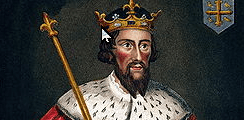
The oldest mention of Denmark (Denemearc) as a designation for a geographically located kingdom is from approx. 890 and is found in two accounts of Alfred the Great, king of the southern English kingdom of Wessex. Here, the northern Norwegian chief Ottar described his sail southern Norway to Hedeby at the Danish southern border (today Germany), while the merchant Wulfstan reported his sail from Hedeby and east wards. The name Denmark actually means the Danes’ “field”, ie. the territory or country of the Danes, or the border area of the Danes.
The Jelling Stones
1. January 0950
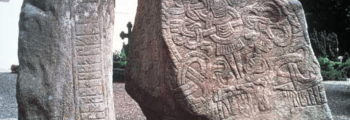
Around the year 950, the king Gorm den Gamle (Gorm the Old) had a large stone placed in Jelling, commemorating his wife Thyra. This text (written with runes) is the oldest written Danish source to mention the name “Denmark”. Around the year 960-985 the king Harald Blåtand (Harold Bluetooth) had an even larger stone placed besides the first one, commemorating his father Gorm den Gamle and his mother Thyra, and declaring that he had conquered all of Denmark and Norway and Christened the Danes. Christianity thus became the official religion of Denmark, and one side of the stone has the oldest depiction of Christ in the nordic countries. The decoration on the stone is thought to have been painted in color originally, but no color remains to this day. The Jelling Stones (and other parts of the area – burial mounds and church) became part of the UNESCO World Heritage List in 1994.
The first churches
1. January 0965

Around the year 965, Denmark was officially Christianized. The first churches were made of wood (stave churches), but already in the 12th century, they were replaced by stone churches. None of the early wooden churches have been preserved. The reconstruction of the stave church from Hørning church gives a qualified idea of what the earliest churches in the country looked like.
The Battle of Svold
9. January 0999
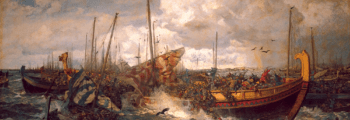
The Battle of Svold was a naval battle in which Erik Jarl of Norway with the help of Svend Tveskæg and Olof Skotkonung of Sweden defeated Olav Tryggvason of Norway in September of the year 999 or 1000. Olav Tryggvason lost his life in the battle. Where the battle took place is unknown; it could be either on Rügen, or in Øresund. The background of the conflict was probably the attempt to establish a united Norwegian kingdom, the political interest of the Danish monarchy in the country, and the spread of Christianity. Olav Tryggvason was on his way home from Venden when his fleet was attacked by an allied Danish-Swedish-Norwegian fleet. Olav Tryggvason had only 11 ships with him and the opponents had more than 70 ships at their disposal.
The invasion by the last Viking king
1. January 1048

Harald Hårderåde became the absolute king of Norway in 1048 and is considered to be the last Viking king. For a number of years he fought with Svend Estridsen over Denmark, but finally recognized Svend as Denmark’s king in 1064.
Sankt Jørgensbjerg Church
1. January 1080

Sankt Jørgensbjerg Church in Roskilde, where parts of the nave’s masonry can be traced back to around 1080 is supposed to be (one of) the oldest of the current churches in Denmark. The very first Danish churches were wooden churches built in the 8th century.
The Battle of Grathe Moor
23. October 1157
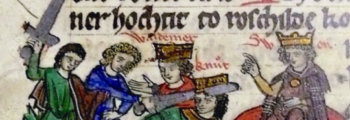
Since 1146, Svend, Knud and Valdemar had all been suitors to the royal power, and in 1157 they agreed to share power, so that Valdemar got Jutland, Knud the Danish islands and Svend got Skåne. On 9 August 1157, they then held a reconciliation feast in Roskilde, but Svend had his men attack the other two kings. Knud was killed, while Valdemar, albeit wounded, managed to escape by knocking over the candlesticks and disappearing into the darkness and reaching Jutland. Valdemar gained a lot of support when people heard about Svend’s misdeeds, and he gathered a large army. He went ashore at Grenå, and by cunning and force succeeded in destroying Svend’s fleet. Svend walked to Randers. At the end of September, Valdemar had become so strong that he dared to meet Svend’s army, and on 23 October 1157 the two armies met at Grathe Hede. The fight was short but fierce. Svend misjudged where Valdemar’s main force was located and realized his mistake too late, and he ended up fleeing. He got into some swamps at Hauge Lake, where he lost his weapons and armor. He was later captured and killed with an ax blow. Valdemar became king of entire Denmark.
Dannebrog falls from the sky
15. June 1219

On this day during the Battle of the Estonian castle, Lyndanise in present-day Tallinn, the Danes’ flag, Dannebrog fell from the sky, the myth says. To the legends about this battle also gradually came a story that as long as Archbishop Anders Sunesen stretched his arms towards the sky, the Danish forces were successful, but when he took his arms down, it went back for the Danes. In the left background of the picture are some monks who help the aged archbishop to keep his arms up so that the victory could be won. The castle fell to King Valdemar 2. Sejr (Valdemar the 2nd Victory) and his forces, which became the turning point in the Danish struggle for dominion in Estonia. The northern part of Estonia was a duchy under the Danish crown, until a later king, Valdemar 4. Atterdag (Valdemar the 4th Again a Day) sold the possession in 1346. Valdemar Day”, June 15, was first introduced as a flag day and national anniversary in 1913 and still is the day today.
The Black Death
1. January 1350
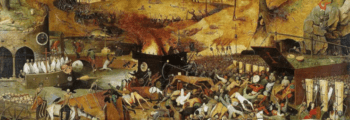
In 1349 or 1350, Denmark was hit by the plague or “The Black Death”, which had worked its way up through Europe from the South within two or three years and in several places killed up to 40% of the population. Denmark was also hit hard. The church had a system where one could pay the priests to pray for one’s soul after death. In 1350, the number of registered soul masses and thus death notices increased. It is not possible to say exactly how the first plague outbreaks affected the population in Denmark, but in the source material from the end of the 14th century and the beginning of the 15th century, so-called desolate farms are mentioned, ie. uninhabited farms whose lands were either cultivated by the neighbors, or which were not cultivated at all. These must be seen as a sign of a decline in population, which was mainly caused by the plague. In some areas, it also appears that a number of churches were closed down as a result of the demographic decline. The plague hit also hard in the cities. In cities like Copenhagen, Roskilde and Ribe, the sources say that there were deserted houses and plots, probably because there were no people to fill them. And in 1354, King Valdemar Atterdag forgave all the death penalty, probably due to lack of population in the country. In fact, the plague seems to have been such a severe blow to the Danish cities that the urbanization the country had experienced earlier in the Middle Ages came to a standstill – at least for a while. Perhaps it hit particularly hard in the cities, which were part of international networks in which the disease spread and where people lived close to each other. Since the first outbreak in the mid-14th century, the plague has returned intermittently. For example, in Denmark during the second half of the 14th century there were four more plague outbreaks, and during the 15th century there were approx. nine in the country. However, the plague hardly had as violent consequences as the first time, i.a. because it gradually became better at dealing with quarantined epidemics. The last plague epidemic hit Denmark in 1711.
The Swedish wars
1. January 1659

Perhaps 1659 was not a great year of horror in world history. But for the Danes, it is a year you can not get around. The Swedish wars of 1657-1660 had terrible consequences for the civilian population, and in a few years between a third and a quarter of the Danish population died. It was quite violent, and there are terrible stories about how people died like flies in a short time, and about priests who had to bury several children in the same coffin because you could not keep up. Many were driven to flee, starved and lived close together and unhygienic. Many died of infectious diseases, women were raped, and people were tortured. It was a mixture of almost all the horrors one could imagine at that time. It affected everyone, both rich and poor, and it was a terrible period to live in with uncertainty about whether one lived the following day. 1659 was a particularly bad year in the period, which was also the year when the Swedes stormed Copenhagen. The wars have consequences that we live with to this day. Denmark lost Scania, Halland and Blekinge, political power, and all the Danes who lived east of Øresund.
Absolute Monarchy
1. September 1660

This new form of government was implemented by King Frederik the 3rd, via a bloodless coup d’état. Before, Denmark was a dyarchy, where the governing power was spilt between the king and the nobility, and the king was elected. Absolute monarchy granted the king ultimate power over the country, and this power was then inherited to his son when the king died, and so forth. King Frederik was to write the new constitution himself, although it was demanded that “the indivisiblity of the nation, a Christian government and the keeping of the priviligies of the social classes” were to be part of it.
Introduction of counties
19. February 1662
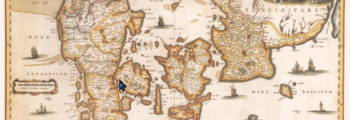
The counties were introduced by royal order into the Kingdom of Denmark on 19 February 1662 to replace the term ‘fiefs’. The number of counties was the same as the number of fiefs, 49, Each county governor usually had several counties under him, the number of county councils was significantly lower. More about the counties.
Land registry
1. January 1688
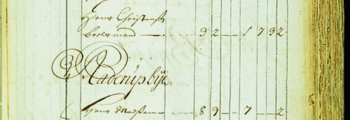
In 1688, Christian V introduced a new land registry, which for the first time determined the tax capacity of all Danish agriculture on the basis of a survey of the land. It was a list of all the farms in a manor, indicating the tax capacity of each farm measured in barrels of hart grain. Land registers were published for all the lords in Denmark in 1662, 1664, 1688 and 1844, respectively. Agriculture was the kingdom’s most important occupation and the hard grain taxes the state’s most important financial basis. The land registers were therefore the tax administration’s most important tool, a simple and effective basis for the vast majority of the taxes imposed on the rural population, which at that time amounted to approx. 80% of the kingdom’s population. The preparatory work for them constitutes the most important source material for the history of Danish agriculture in the 17th century, especially the preparatory work for the land register 1688, the so-called field books from 1682-83, which contains a survey of each village’s adjacent farm by farm with accompanying description of land quality. the cultivation system used and the access to the hay, grazing, fuel, beneficial timber, etc.
The last Plague
10. January 1711
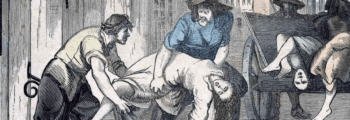
On January 10, 1711, the long-feared message arrived: The plague had crept into Denmark. The disease had broken out in Poland in 1709, where it spread to the neighboring countries via the port of Danzig, but the Danish authorities managed to keep the plague at bay with preventive measures that were in line with the latest knowledge in the field. King Frederik IV had gained some experience in preventing plague on his great trip abroad in 1708. So when the plague broke out in Poland, he immediately took action and established a quarantine station on the small island of Saltholm in the Sound. Suspicious ships had to anchor on Copenhagen’s Red and crew as well as goods spend 40 days on Saltholm before they had to call at Copenhagen. Measures were also taken in Elsinore, and the king banned the trade in plague-stricken towns. Nevertheless, an epidemic broke out on Zealand, and at the end of May the plague was a reality in Copenhagen, and it raged violently in the hot summer. In October, however, the plague subsided, but by that time at least 23,000 people, corresponding to a third of Copenhagen’s population, had died, and more than 500 houses were empty. However, it did not take long before the capital got back into gear. People from the country flocked to take over an empty house or a closed business. Craftsmen could easily get jobs, and many seized the chance of a life in the capital. Although the plague of 1711 did not become as violent as it could have been, it left deep scars and overcrowded cemeteries. Fortunately, this was the last time that the dreaded disease visited Denmark.
Adscription
4. February 1733
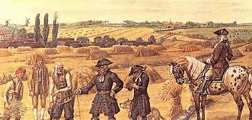
Adscription was implemented on February 4, 1733. It prevented male workers between the age of 14 to 36 years old, from leaving the manor they belonged to by their birth without the lord of the manor’s consent. In 1742, the age limit was expanded to include males from 9-40 years old, and again in 1764 where boys down to the age of 4 were also bound by the law. In some cases, the farmhands were lucky enough to get (or pay for) permission from the lord to seek work elsewhere, and many simply tried running away in hope of a better life at another place. Adscription was officially abolished on June 20, 1788, but it was effectively still in place until the turn of the century.
Christening and Confirmation
1. January 1736

In 1736, christening and confirmation became mandatory.
The first Census
15. August 1769

The first census in Denmark was conducted on 15 August 1769. The total population of the Kingdom of Denmark was 814,238. The local authorities simply had to report the total numbers to The Central Statistical Bureau of Denmark which has not retained the original lists. All following censuses all censuses were conducted using pre-printed forms. Until 1970, a total of 27 nationwide censuses were conducted.
Census
1. July 1787
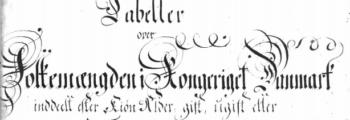
The content was: Address/location, name, family status, age, marital status, marriage number, occupation. The total population of the Kingdom of Denmark was 840,045.
Abolition of Adscription
20. June 1788

Adscription was officially abolished on June 20, 1788, but it was effectively still in place until the turn of the century. Initially, the reorganization included only those under 14 years of age. Later, men 36 years or older – and later again, those men who had served as a soldier. The main point of this administrative reform was that the bond to the estates was changed to a bond to the conscription district. The autocracy was now so developed that the state could to a greater extent itself be responsible for enlistment in the army; there was less need for the landowners as the local administrative link. The Adscription was implemented on February 4, 1733
Royal Decree to ban Slave Trade
16. March 1792
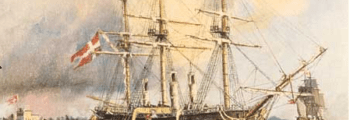
Denmark participated in the slave trade from the 1660s to the beginning of the 19th century and transported around 111,000 Africans across the Atlantic under inhumane conditions. The Danish slave journeys most often went along the infamous triangle route. It went from Denmark to the Gold Coast, from there along the so-called intermediate passage across the Atlantic with slaves to the Danish West Indies and then home with raw sugar to Denmark. In the 1790s, however, merchants and shipowners in the Danish West Indies themselves began sending ships directly from there to Africa to pick up slaves. After a thorough preparation, it was decided by royal decree of 16 March 1792 to ban the transatlantic slave trade under the Danish flag and Denmark became the first country in the world to ban its slave trade. However, the ban did not take effect immediately, but did not apply until 1803, which meant that a number of countries came before Denmark with an actual ban on slavery.
Redistribution of the counties
21. June 1794
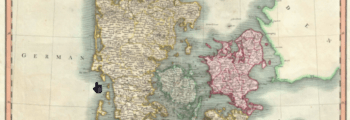
By royal resolution of September 4, 1793, and decree of June 21, 1794, a new division into 24 counties was introduced. More about the counties.
Census
1. February 1801
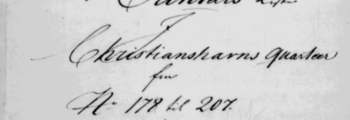
The content was: Address/location, name, marital status, age, marital status, marriage number, occupation. The total population of the Kingdom of Denmark was 925,680.
Prohibition of Slave Trade
1. January 1803

16 March 1792 the transatlantic slave trade under the Danish flag was banned by royal decree and Denmark became the first country in the world to ban its slave trade. However, the ban did not take effect until 1 January 1803, which meant that a number of countries came before Denmark with an actual ban on slavery. In the intervening ten-year period, the import of new slaves to the Danish West Indies was financially supported by the state. The intention was to build up such a large and gender-balanced slave population that it could reproduce itself, so that there was no need to bring in new slaves from Africa. Paradoxically, the result was that precisely in this transitional period from 1793 to 1802, the Danes brought more slaves to Africa than ever before or after. It involved a total of 24,900 slaves on 125 voyages, equivalent to a ship with 200 new slaves every single month. Slavery was a well-integrated part of the economy in Denmark and many other European countries. An illegal but limited slave trade under Dannebrog continued after 1 January 1803, and Danish sailors participated in the trade on foreign ships, just as the Danes, who were stationed on the Gold Coast, to a certain extent continued their human trafficking.
Copenhagen Bombing
2. September 1807

At the Peace of Tilsit in July 1807, France and Russia agreed to force the neutral states, including Denmark, to turn to England. When the English government became aware of this, a lightning attack was launched on Denmark with the intention of seizing the Danish navy. The superior English fleet began a blockade of Zealand on 2 August, and from 16 August an army of 30,000 war-weary troops was landed North and South of the city. Denmark declared war on England, but the invaders met no resistance, and soon Copenhagen with its obsolete fortifications was under siege. On September 2, the British launched a violent night bombardment of Copenhagen, and after three days of shelling, the commander of the capital capitulated and handed over the home part of the fleet and its materiel. Parts of the city’s southwestern quarter were burnt down, approx. 300 properties totally destroyed, and over 1500 damaged. The extent of the terrorist bombing’s human losses has been fraught with great uncertainty; according to tradition, lost approx. 1600 people were killed and an equal number were injured. Recent research indicates a lower number of killed, namely approx. 400.
Smallpox epidemics
3. April 1810
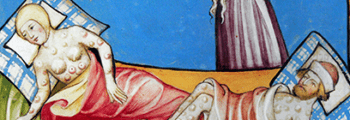
In the early 1800s, Denmark was hit by a series of smallpox epidemics. Smallpox was a highly contagious infectious disease that resulted in high fever and blisters all over the body. April 3, 1810, King Frederik VI and the Danish Chancellery, together with the Vaccination Commission, drafted an ordinance on smallpox vaccination for Denmark and Norway. The regulation could not force people to be vaccinated, but it was a prerequisite for, for example, confirmation, marriage, schooling, apprenticeship, and military service, that one could document that one had overcome a smallpox disease or undergone the vaccination. Indirectly, it was a matter of coercion.
Parish Register Ordinance
11. December 1812

A parish register officially called a ministerial register, is a register of ecclesiastical acts in the parish. Births, christenings, confirmations, marriages (and betrothals), deaths and funerals are registered. In some editions also accession and expunctions to and from the parish. The content has varied a lot over time. The very first parish registers were started in the 16th century. In 1645, the keeping of parish records was mandated by law. However, the law did not lay down any detailed rules on how the parish registers were to be kept. Therefore, the oldest parish registers up till around 1813 were quite different in form and content. By ordinance of December 11, 1812, it was decided that in future the parish registers should be kept in duplicate, the main ministerial register and the counter-ministerial registerAt the same time, it was decided that they should be kept in pre-printed protocols with special sections for christened, confirmed, marriages and deaths distributed by each sex.
State Bankruptcy
5. January 1813
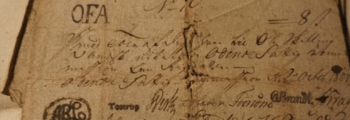
Ordinance on Change in the Monetary System of the Kingdoms of Denmark and Norway, as well as the Duchies of Schleswig and Holstein, known as the Money Reform or State Bankruptcy on 5 January 1813, was issued as a result of Denmark’s participation in the Napoleonic Wars. Military spending had grown sharply, while state revenues stagnated. Therefore, the state began to send more money into circulation, which led to very strong inflation and major economic problems. During 1812, the state was no longer able to pay its debts, so the state was virtually bankrupt.
The first real Education Act
29. July 1814

There were actually three individual acts for Copenhagen, the market towns and the rural areas, respectively. The acts stipulated that all children should go to school from the age of 7 until they were confirmed when they were about 14 years old.
Establishment of The Central Bank
4. July 1818
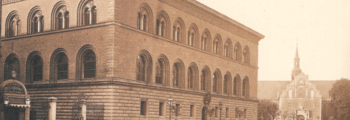
Danmark’s Nationalbank (The Central Bank) was established as a private bank in 1818 to create order in the monetary system. The background was that the huge deficits in the state budget during the Napoleonic War were financed by letting the banknote press run. This led to very high inflation and the need for radical monetary reform. The King signed Nationalbanken’s “constitution” on 4 July 1818. It gave Nationalbanken permission to conduct central bank activities and the exclusive right to issue banknotes. The private ownership was to cement the bank’s independence from the state and strengthen confidence that the state did not again use the banknote press to finance its expenses. The group of shareholders consisted mainly of the country’s property owners and they did not have a direct influence on the bank’s management – they were largely only entitled to share dividends. This was to ensure that Danmarks Nationalbank was not only independent of the state, but also of narrow private shareholder interests. By law of 7 April 1936, Danmarks Nationalbank was transformed into a self-governing institution.
Christening decree
1. January 1828

In 1828, Frederik VI issued a christening decree, in which it was stated that every child should be christened “not only with a first name but also with the family name that it should bear in the future.” If the family did not already have a family name, it was up to the father to determine the child’s surname. The fathers were even given a number of choices when choosing surnames for the pods: • The father’s own surname • Father’s first name followed by a -sen (patronymic) • A place name that the family was associated with
Census
18. February 1834
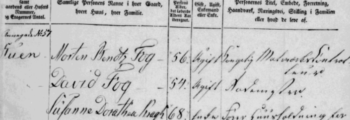
The content was: Address/location, name, age, marital status, occupation/family status (in Holstein also religion). The total population of the Kingdom of Denmark was 1,223,797
Assemblies of the State
15. May 1834
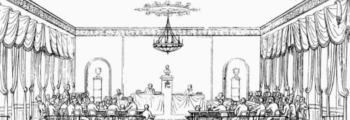
The composition of the estate assemblies was announced on May 15, 1834. Earlier in In 1834, King Frederik VI and the Council of State, passed a law establishing four estate assemblies in the Kingdom of Denmark and the Duchies. They were to be located in Itzehoe for Holstein, Schleswig city for Schleswig, Viborg for Jutland and Roskilde for Zealand and the islands. By establishing four assemblies, the unity of the kingdom was signaled, and that all parts of the kingdom were to be treated equally, which was an extension of the autocracy’s all-state policy. Voters were to vote by estate in three groups: landowners, landowners in the market towns, and small landowners, i.e. freeholders, tenant farmers, and a few others. The estate assemblies were advisory only, so the king did not necessarily have to conform to the results they came up with. Their task was to discuss the government’s bill, but over time it became more and more common for the assemblies themselves to come up with proposals and the estates assemblies’ greatest importance lay immediately in the cases they raised on their own, which had previously been difficult in an autocratic societies with state censorship. Despite many restrictions, the advisory estate assemblies received e.g. importance for the Danes’ opportunity to debate and engage in the major political issues of the time, and they helped to create a political awareness in large parts of the population, which pointed in a more democratic direction. For the Kingdom of Denmark, the assemblies of estates met for the last time in 1848 and officially ceased to function after the adoption of the June Constitution of 1849.
Census
1. February 1840
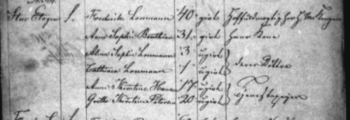
The content was: Address/location, name, age, marital status, occupation/family status (in Holstein also religion). The total population of the Kingdom of Denmark was 1,283,027.
Census
1. February 1845
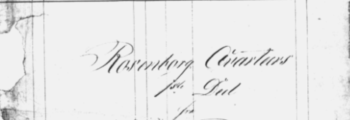
The content was: Address/location, families/household, name, age, marital status, place of birth, occupation/household. The total population of the Kingdom of Denmark was 1,350,327.
Freedom of the Slaves
3. July 1848

The transports with slaves to the Danish West Indies continued until the British occupied the colony at Christmas time 1807. However, the slave trade continued internally on the three Danish West Indies islands of St. Thomas, St. John, and St. Croix until 1848. Denmark was at that time under growing pressure to free the slaves in the Danish West Indies. In 1847, a royal Danish decree ruled that slavery should cease after a 12-year transition period, while future children born to slaves should be free immediately. The slaves would not wait for their freedom and a slave revolt broke out at Frederiksted on St. Croix. Governor-General Peter von Scholten – who was a strong supporter of the liberation of the slaves and from 1830 worked purposefully to improve their legal position – decided not to fight the revolt and instead declared on his own initiative the slaves released with immediate effect on July 3, 1848.
The first Constitution
5. June 1849
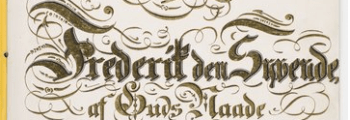
On June 5, 1849, King Frederik VII signed Denmark’s first Constitution which replaced the Royal Law of 1665 and marked the transition from autocracy to constitutional monarchy and a more democratic form of government. The Constitution was at the time a major step towards more democracy and contained among other things the following key decisions: 1) The Parliament was to consist of two chambers, the Folketing and the Landsting. Only infamous men over 30 with their own household who did not receive or had not received poverty support had the right to vote for the two chambers, i.e. about 15% of Denmark’s population got access to vote in 1849. 2) Civil liberties: freedom of expression, press, association and assembly, inviolability of property rights and prohibition of arbitrary imprisonment. 3) The Evangelical Lutheran Church was the Danish National Church.
Emigration to America
1. January 1850
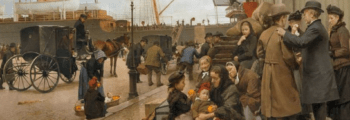
Hundreds of thousands of Danes traveled to the United States in the 19th century and well into the 20th century. Between 1820 and 1930, almost 336,000 Danes went to the United States. They made up a small splash in a global wave of 38 million emigrants heading for the United States. The vast majority of Danes left after 1867. While the US census in 1850 registered 1,837 people born in Denmark, the corresponding figure in 1880 was just over 64,000 and in 1900 159,000. It culminated in 1920 with just over 189,000 and then dropped to almost 179,500 in 1930. Including the immigrants’ American-born children, the peak was reached in 1930, when the census registered 529,000 Danish Americans, corresponding to 15 percent of Denmark’s population the same year. With the transition from sailing to steamship sailing in the decades after 1850, the voyage across the Atlantic became faster, safer, and more stable. Usually, the journey now lasted a maximum of 14 days. With the launch of the steamship company Thingvalla in 1879 – which in 1897 was acquired by DFDS and renamed the Scandinavia-America Line – the Danes could sail directly from Copenhagen to New York City. The painting from 1890 ‘Emigrants on Larsens Plads’ depicts the atmosphere before the emigrants board one of the Thingvalla Line’s Atlantic steamers and sail from Copenhagen to New York City.
Census
1. February 1850
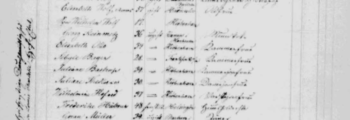
The content was: Address/location, families/households, name, age, marital status, place of birth, occupation/family, disability. The total population of the Kingdom of Denmark was 1,407,747.
Census
1. February 1855
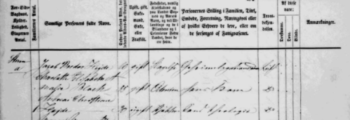
The content was: Address/location, families/households, name, age, marital status, place of birth, occupation/family, religion, disability. The total population of the Kingdom of Denmark was 1,499,850.
The Constitutional Act
2. October 1855
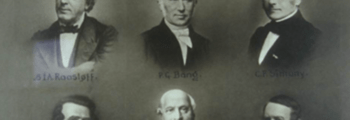
The Constitutional Act for the Commonwealth of the Danish Monarchy, also known as the “Helstatsforfatningen” or Fællesforfatningen, was passed on 2 October 1855. After the Firs Schleswig War 1848 – 1850, the great nations had in 1851 ordered the Danish government to restore the whole state under Danish rule. This meant that a common constitution had to be made for the entire Danish monarchy, which consisted of the Kingdom of Denmark and the three duchies of Schleswig, Holstein and Lauenburg.
Census
1. February 1860
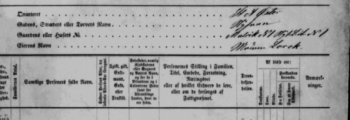
The content was: Address/location, families/households, name, age, marital status, place of birth, occupation/family, religion, disability. The total population of the Kingdom of Denmark was 1,600,551.
Prussia and Austria enter Schleswig
1. February 1864
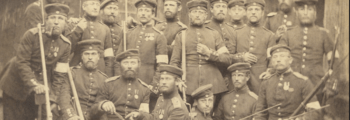
Prussian and Austrian soldiers crossed the border into Schleswig at Ejderen, and Denmark was at war again. The day before field marshal von Wrangel handed over a declaration of war by letter to the Danish Chief General Christian de Meza.
The Retreat from Dannevirke
5. February 1864

Towards the afternoon of 5 February 1864, the Danish soldiers secretly and under cover of darkness began to escape the Danish fortress, Dannevirke, which politicians in Copenhagen unrealistically regarded as impregnable. But, as the military leaders knew, would not be able to withstand attacks from the superior enemy at all. The Danish army was on the run from the superior Prussian and Austrian troops, which the Danish General Staff, led by the eccentric and wise General Christian Julius de Meza, judged were encircling the Danish army. A 30-kilometer-long snake consisting of 40,000 Danish soldiers, hundreds of chariots, cannons and 10,000 horses moved from the national fortification Dannevirke near the city of Schleswig in the direction of Flensburg. Everything was heavy, dark and terrible this fateful afternoon, evening and night February 5, 1864: Biting wind and frost. An exhausted and demoralized army that had been fighting for days in the winter cold and lacked food, warmth and accommodation. Terrible roads, where carriages and men slipped, but at the same time you had to move forward quickly before the enemy discovered that the fortifications at Dannevirke had been evacuated.
Census
1. February 1870
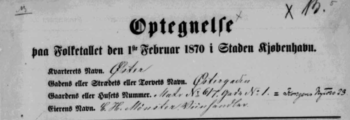
The content was: Address/location, families/household, name, age, marital status, place of birth, occupation, marital status, religion, disability. The total population of the Kingdom of Denmark was 1,784,741.
Smallpox vaccination
4. February 1871

By law, the smallpox vaccination became compulsory when a child reached 7 years. If a child was not vaccinated, the parents were fined.
The Battle on the Common
5. May 1872
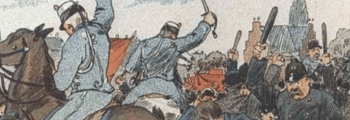
“The Battle on the common” is the term for the first and only open confrontation of early Danish socialism with the authorities. The battle took place as a major battle between protesters, soldiers and police on Sunday 5 May 1872 at Nørre Fælled [Northern Common] in Copenhagen. With the publication of the pamphlets Socialistisk Blade [Socialistic Papers], Louis Pio paved the way for the socialist movement in Denmark. Together with others, he drew attention to the conditions of the workers in Denmark and on 15 October 1871 founded “International”; a Danish branch of the International Workers’ Association for Denmark, which in record time gained many members because rising living costs were not followed by rising wages. The direct occasion for “The Battle on the Common” was Louis Pio’s call for a mass meeting in connection with an extensive strike among the bricklayers in Copenhagen. Louis Pio and the newspaper “The Socialist” strongly supported the bricklayers, but the financial means to maintain the strike were small, so Pio convened a public meeting instead. Louis Pio’s call was accompanied by a raging outcry and his threatening formulations in the article were interpreted by government and police as a call for revolution. The Chief of Police banned the meeting via notices in the streets of Copenhagen, and on the night of 5 May he arrested Louis Pio and other members of the Danish branch of the “International”. Many workers showed up at the common despite the police ban. They were attacked by the police and hussars and there was casualties on both sides. No one was killed. With the intervention, the government and police wanted once and for all to stem Pio’s movement. The violent incident meant prison sentences for the leaders and a weakening of the early labor movement. Louis Pio was given a marginal role in the labor movement after his imprisonment and emigrated to America in 1877.
Census
1. February 1880
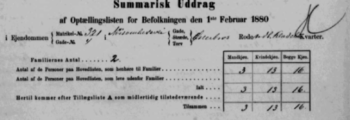
The content was: Address/location, families/households, name, gender, age, marital status, religion, place of birth, occupation/family, disability. The total population of the Kingdom of Denmark was 1,980,259.
Census
1. February 1890
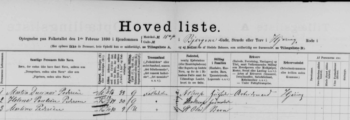
The content was: Address/location, families/households, name, gender, age, marital status, religion, place of birth, occupation/family, disability. The total population of the Kingdom of Denmark was 2,185,335.
Census
1. February 1901
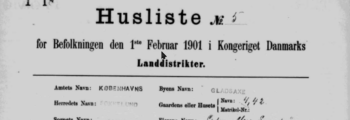
The content was: Address/location, article number, name, gender, date of birth, marital status, religion, place of birth, place of residence, occupation/family, place of work, disability. The total population of the Kingdom of Denmark was 2,449,540.
Census
1. February 1906
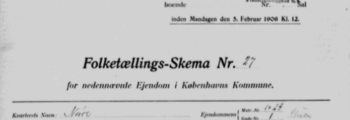
The content was: Address/location, article number, name, gender, date of birth, marital status, religion, place of birth, place of residence, occupation/family, place of work, disability. The total population of the Kingdom of Denmark was 2,588,919.
Census
1. February 1911
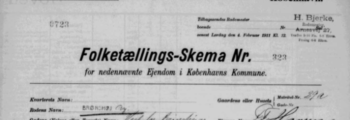
The content was: Address/location, article number, name, gender, date of birth, marital status, religion, place of birth, place of residence, occupation/family, place of work, disability. The total population of the Kingdom of Denmark was 2,757,076.
Census
1. February 1916
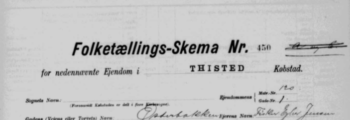
The content was: Address/location, name, gender, date of birth, religion, occupation/marital status, disability. The total population of the Kingdom of Denmark was 2,921,362.
The Danish West Indies sold to the US
31. March 1917
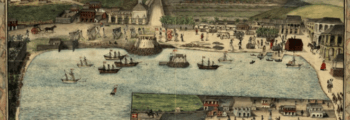
The Danish West Indies (today the United States Virgin Islands) consisted of the three Caribbean islands St. Thomas, St. John and St. Croix. The islands were in Danishian possession from 1672, 1718 and 1733, respectively, until they were sold to the United States on March 31, 1917. The three islands were the most important of the Danish colonies in the tropics. In the middle of the 17th century, Danish ships began sailing in the West Indies, and in 1665-66 a futile attempt was made to colonize the uninhabited island, St. Thomas. In 1671 a West Indian company was formed, and in 1772 a new, successful attempt was made to colonize the island. After a difficult start, the production of sugar gradually began, and in 1718, despite English protests, the somewhat smaller neighboring island, St. Jan, was taken over. In 1733, the slightly remote St. Croix was bought by the French. The acquisition of St. Croix almost tripled the area of the Danish holdings in the West Indies. Today, all preserved sources of the Danish West Indies are available at the National Archive in Copenhagen.
Census
1. February 1921
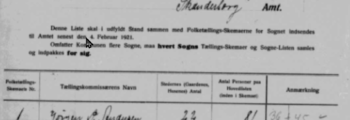
The content was: Address/location, article number, name, gender, date of birth, marital status, religion, place of birth, place of residence, occupation/family, place of work, disability. The total population of the Kingdom of Denmark was 3,267,831.
Census
5. November 1925
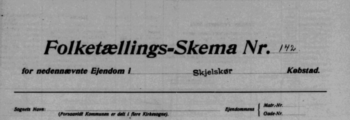
The content was: Address/location, name, gender, date of birth, place of birth, citizenship, marital status, family, occupation, residence 1924, notes. The total population of the Kingdom of Denmark was 3,434,555.
Census
5. November 1930
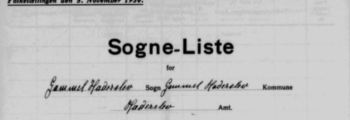
The content was: Address/location, name, gender, date of birth, place of birth, citizenship, marital status, family, occupation, name and address of employer, disability, number of marriages and children, residence 1929, notes. The total population of the Kingdom of Denmark was 3,550,656.
Census
5. November 1935
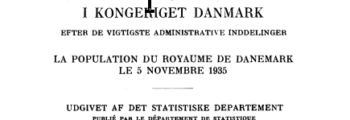
No individual answers, only statistics. The total population of the Kingdom of Denmark was 3,706,349.
Germany occupies Denmark
9. April 1940

Nazi-Germany invaded and subsequently occupied Denmark early in the morning April 9, 1940. The invading forces were overwhelming in numbers, and capitulation quickly followed. 16 Danish soldiers were killed and 23 wounded. Large parts of the populace resented the government for not resisting the invasion further, but the cooperation from the Danish government did actually facilitate the rescuing of the Danish Jewish citizens afterwards.
Census
5. November 1940
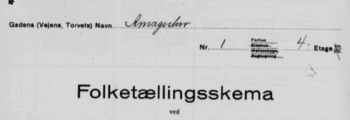
The content was: Address/location, name, gender, date of birth, place of birth, citizenship, marital status, family, occupation, disability. The total population of the Kingdom of Denmark was 3,844,312.
The Liberation of Denmark
5. May 1945
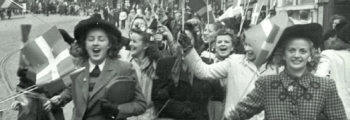
On the evening of May 4, the capitulation of German forces in north-western Germany, the Netherlands and Denmark was announced through the British radio channel BBC, via a now iconic radio transmission. Denmark was officially liberated the morning of May 5 (except for the island of Bornholm, located in the Baltic sea, that was being occupied by Soviet forces until April 5, 1946. Outside of massive celebrations that followed, there was also armed conflicts between the resistance fighters and Nazi sympathizers.
Census
15. June 1945
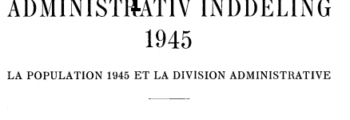
No individual answers, only statistics. The total population of the Kingdom of Denmark was 4,045,232.
Census
5. November 1950
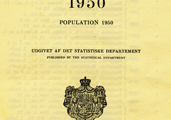
The individual answers are not yet available to the public. The total population of the Kingdom of Denmark was 4,281,275.
Census
1. October 1955
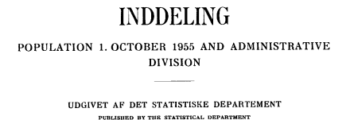
No individual answers, only statistics. The total population of the Kingdom of Denmark was 4,448,401.
Census
26. September 1960
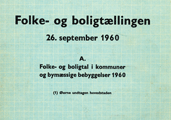
The individual answers are not yet available to the public. The total population of the Kingdom of Denmark was 4,585,256.
Census
27. September 1965
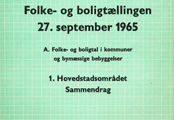
The individual answers are not yet available to the public. The total population of the Kingdom of Denmark was 4,767,597.
Local government reform
1. July 1970
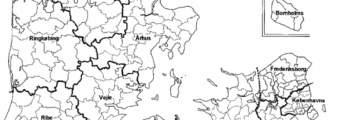
The local government reform in 1970 was the largest reform to date of the Danish local government. The number of counties was reduced from 24 to 14 (and the number of municipalities from 1,098 to 277). More about the counties.
The last census
9. November 1970
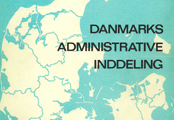
The individual answers are not yet available to the public. The total population of the Kingdom of Denmark was 4,937,579.
Greenland Home Rule Government
1. May 1979
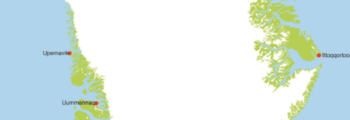
The Home Rule Government of Greenland was introduced on 1 May 1979, which meant that the National Council was replaced by an actual parliament, the Greenland Parliament, which gained authority over areas such as education, health, fisheries and environmental policy. An indicative referendum in Greenland on 17 January 1979 had shown a 70% majority in favor of the proposal. The Home rule was later extended to cover the majority of possible responsibilities, while responsibility for security and foreign policy, as well as full administration and the right to the underground, remained a matter for the Danish Commonwealth. In the relationship between Denmark and Greenland, the Home Rule Act was the subject of a number of disputes; in particular issues such as the right to the underground and the status of the people under international law marked the dividing lines. Section 1 of the Home Rule Act began with the sentence: “Greenland constitutes a special community within the Danish kingdom”, where many would instead claim that Greenland has its own population group, which constitutes an independent people in the sense of international law. The right to the subsoil belonged to the Danish Commonwealth, and the issue is particularly relevant in connection with the extraction of raw materials (oil, gas, minerals, etc.). An agreement was reached that any profits from extraction will be shared between Denmark and Greenland. Since the introduction of the Home Rule Government, the political debate in Greenland has been characterized by these two themes.
The Strucural Reform
1. January 2007
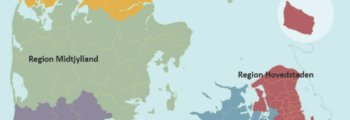
The so-called Structural Reform replaced the country’s 14 counties by five regions (and the number of municipalities was also greatly reduced; from 270 to 98. More about the counties.
Home Rule Government of Greenland replaced by Self-Government
21. June 2009

The Greenland Home Rule Government refers to the Greenlandic government system, which operates within the framework of the Danish Commonwealth. The Greenland Self-Government was introduced on 21 June 2009. Through the new law, the Greenland Home Rule Government has been given the opportunity to repatriate a number of areas, including the right to manage the subsoil, which was not an option under the previous Home Rule Act. A guiding principle in the new Self-Government Act is that the Greenland Self-Government itself can choose to take on new areas of responsibility. Unlike before, these acquisitions do not involve financial resources.
My Danish Roots
1. April 2013




